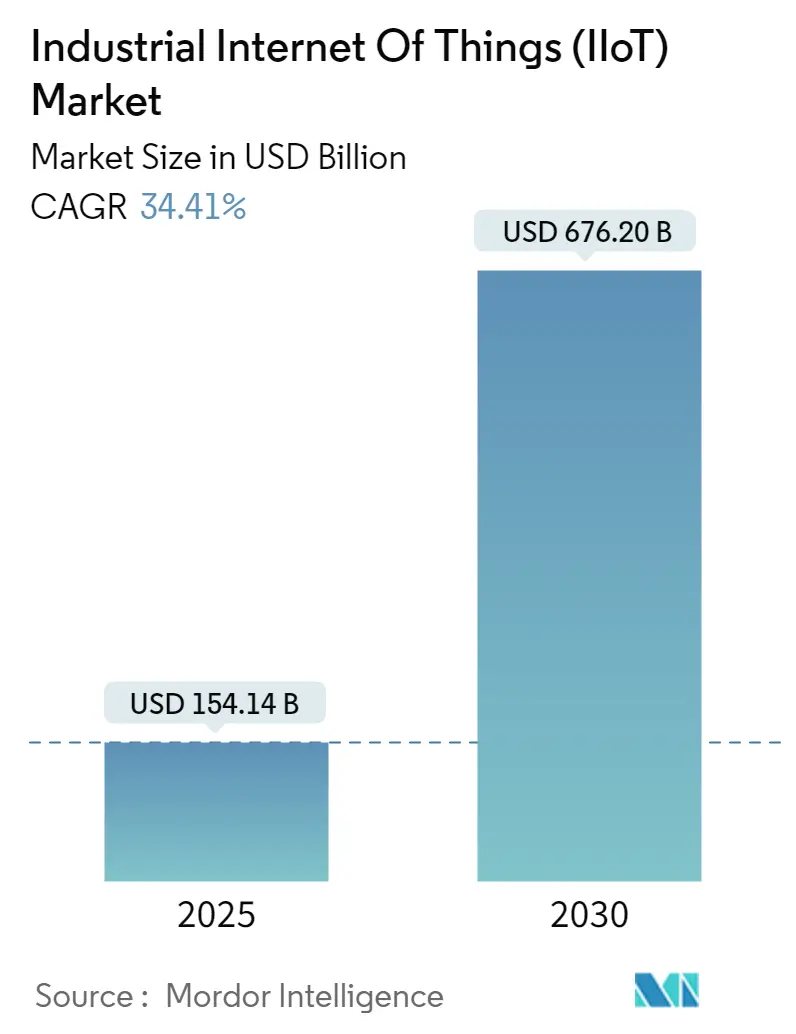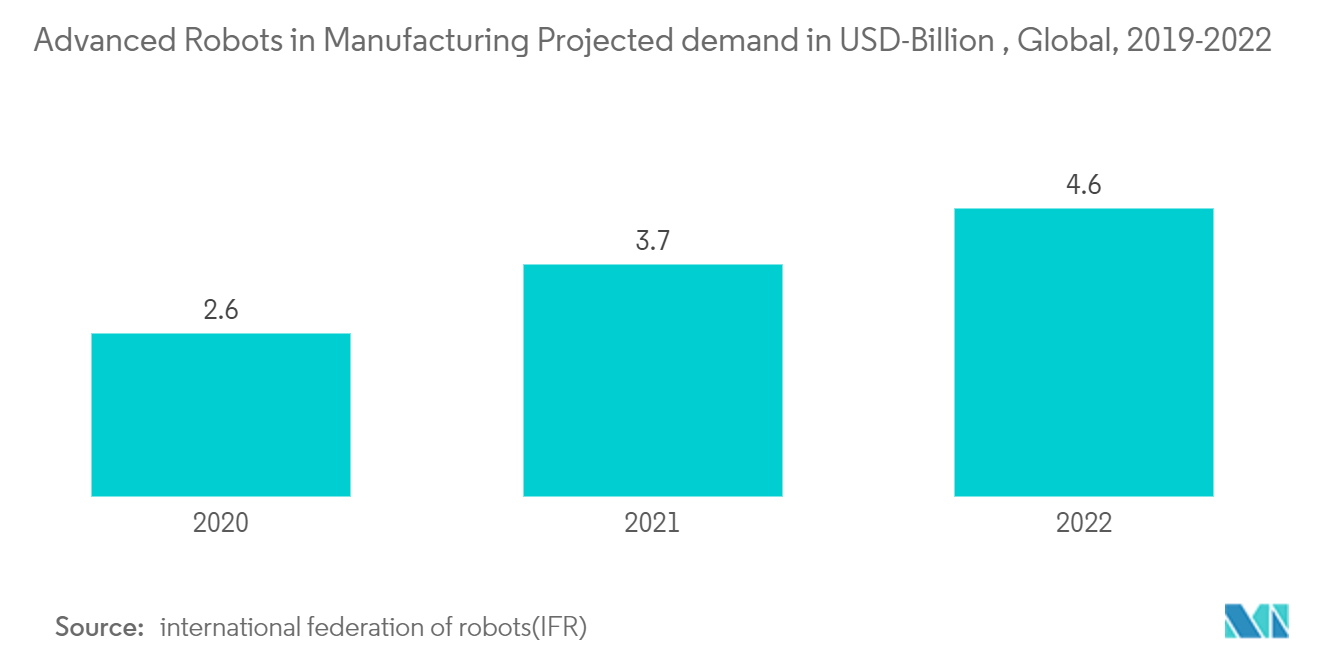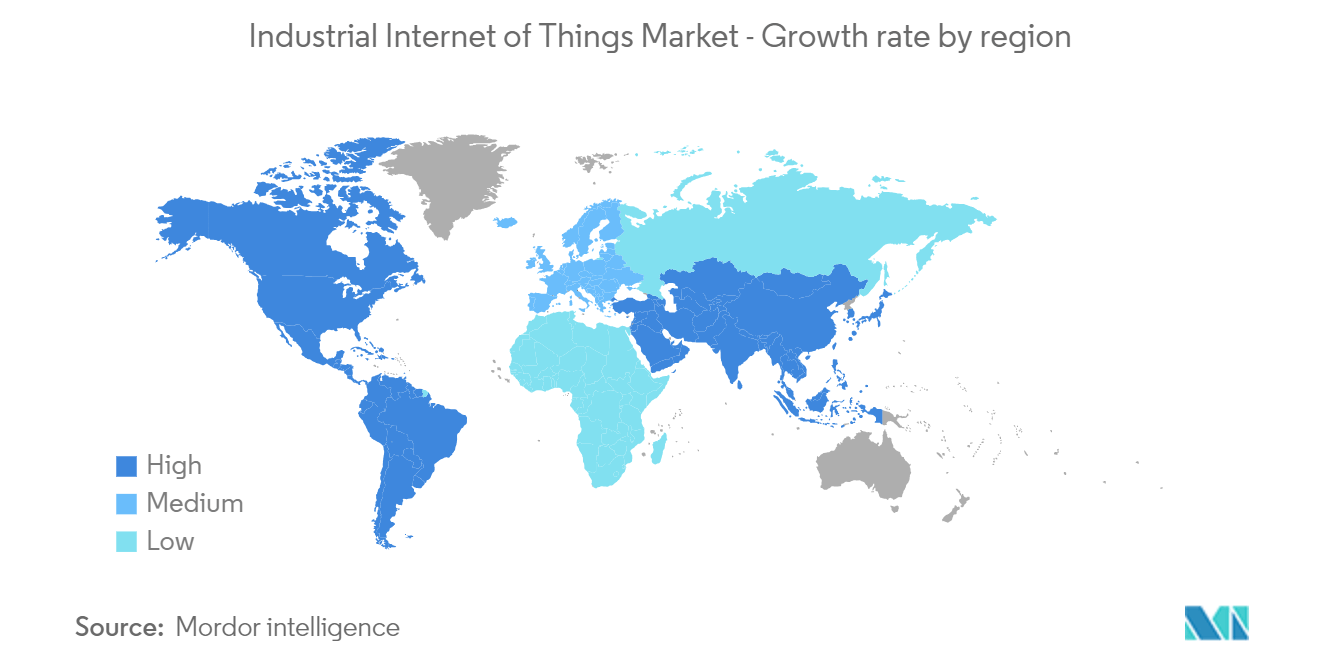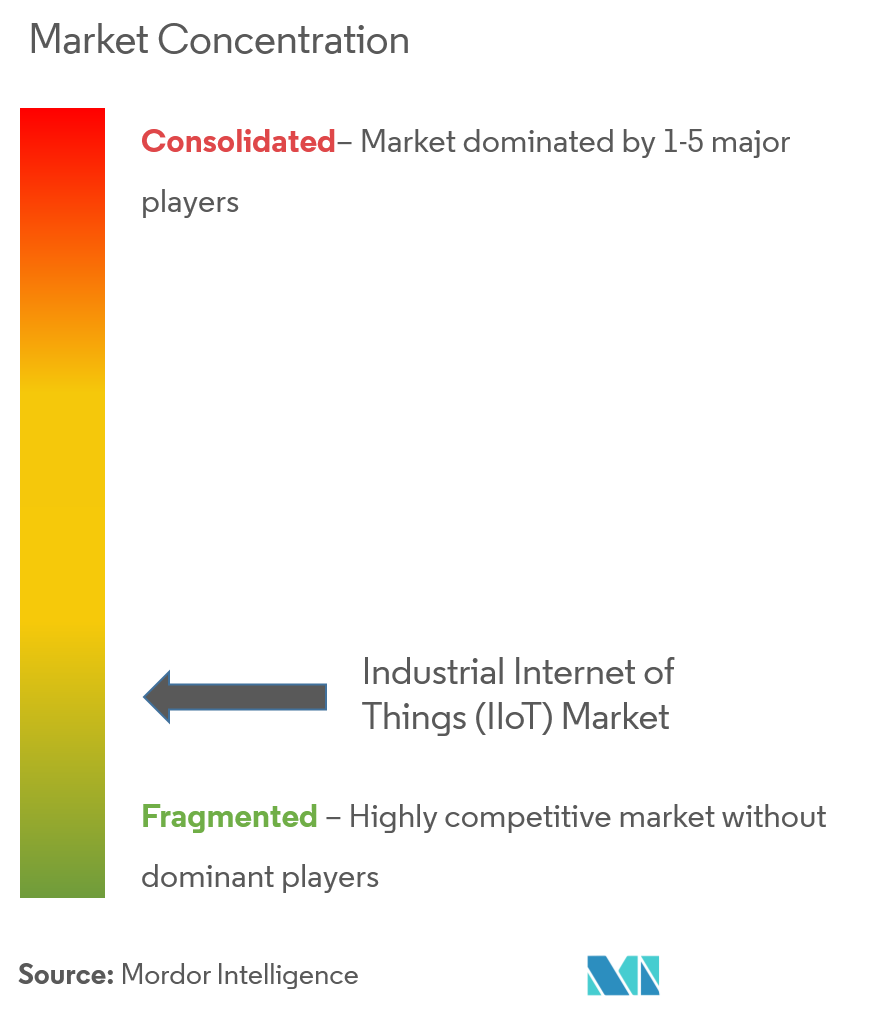
| Study Period | 2019 - 2030 |
| Market Size (2025) | USD 154.14 Billion |
| Market Size (2030) | USD 676.20 Billion |
| CAGR (2025 - 2030) | 34.41 % |
| Fastest Growing Market | Asia Pacific |
| Largest Market | Asia-Pacific |
| Market Concentration | Low |
Major Players_(7).webp)
*Disclaimer: Major Players sorted in no particular order |
Industrial Internet of Things (IIoT) Market Analysis
The Industrial Internet Of Things Market size is estimated at USD 154.14 billion in 2025, and is expected to reach USD 676.20 billion by 2030, at a CAGR of 34.41% during the forecast period (2025-2030).
- Technologies, such as big data and machine learning (ML), are being used increasingly to harness the data generated from connected devices to improve machine-to-machine (M2M) communication and streamline workflow. Also, declining manufacturing and sensor costs in producing IoTs further drive the demand.
- Significant advantages, such as large-scale profit margins through improvements in power efficiency, attract companies to invest in the market aggressively. According to a study by Microsoft, IoT is increasingly becoming indispensable to the manufacturing industry. 87% of IoT decision-makers in the industry have adopted IoT, and the vast majority say IoT is critical to the success of their company and that they are satisfied with the technology.
- Furthermore, the utilization and demand for edge computing in Industrial IoT are rapidly increasing due to its next-generation capabilities. For instance, in the current year, SECO, an Italian high-tech company, has announced a strategic partnership with Qualcomm Technologies International, Ltd—the goal of introducing innovative edge computing products and solutions tailored for the industrial Internet of Things (IIoT). Under the agreement, SECO is appointed Qualcomm Technologies IIoT design center partner, responsible for creating specific reference designs for readily available hardware solutions, primarily targeting OEM customers.
- Market incumbents like Google, Amazon Web Services, and Microsoft aim to establish more collaborative partnerships with edge-computing companies to provide one-stop solutions to industrial users. Further, the growing number of industrial robot installations globally is expected to create considerable demand for low latency and jitter communications, significantly improving the need for IIoT solutions.
- AWS IoT TwinMeker introduces three new entity modeling features to streamline the creation, deployment, and scalability of digital twins for real-world systems: Firstly, customers can now perform metadata bulk operations, including import, export, and update, facilitating the seamless migration of equipment models and metadata for external sources or different AWS accounts. This simplifies the creation of entity models at scale. Secondly, AWS IoT TwinMaker service quotas have been increased to support digital twins with higher entity and component counts. Third, introducing composite component types enhances flexibility and efficiency in constructing complex components.
- Moreover, metadata bulk operations and composite components are accessible in AWS IoT SiteWise, ensuring a consistent modeling experience for industrial customers across all regions where AWS IoT TwinMaker is generally available, except for metadata bulk operations, which are inaccessible in AWS GovCloud. Such developments were expected to influence future and current ongoing IIoT projects as they might be deemed non-essential and either postponed or canceled for the foreseeable future.
Industrial Internet of Things (IIoT) Market Trends
Manufacturing to Hold Major Market Share
Amongst the industries, the manufacturing industry holds a significant share of investment and market share, with both discrete and process manufacturing intensely investing in IoT adoption. Furthermore, there is a strong emphasis on integrating IoT within the industry, especially with the emergence of Industry 4.0. IoT is making significant strides in discrete and process manufacturing by providing avenues for operational optimization, downtime reduction, enhanced efficiency, facilitating data-driven decision-making, and ultimately contributing to increasing profit margins while minimizing costs, thus ensuring a swift return on investment (ROI) in IoT adoption.
For instance, according to the survey of Ubisense, a precise location, movement, and interaction of things tracker, the survey provides a clear snapshot of the 2023 manufacturing landscape, indicating that 62% of manufacturers have incorporated IoT technologies into their manufacturing or assembly processes. This significant increase in adoption highlights are growing acknowledgement of IoT's substantial potential to streamline operations and boost productivity.
In the upcoming years, utilities, discrete manufacturing, process manufacturing, and life sciences sectors will spend the most on IoT solutions. Most use cases are anticipated to continue enhancing asset tracking, asset life, and the ability to enforce physical distance through condition-based equipment tracking and maintenance.
The adoption rates from the industry are expected to be higher than any other industry due to the increased propensity of decision-makers to adopt IoT solutions. According to a study by General Electric, 58% of manufacturers mentioned IoT is required to transform industrial operations digitally.
In addition, a study by Capgemini found that industrial manufacturing held the second-highest average implementation percentage of high potential use cases by industries after telecom, which stood at 33%, focusing on production asset maintenance, manufacturing intelligence, and product quality optimization.
In addition, the adoption of industrial robots in manufacturing industries is expected to increase further over the coming years. For instance, according to IFR, the global demand for advanced robots in manufacturing is expected to grow; owing to such developments, various other aspects of the manufacturing industry, such as in-house logistics, inventory, and warehouse management etc., are also expected to be automated over the coming years.
According to a study by Microsoft, 87% of the manufacturing industry's decision-makers favored adoption, with industrial automation, quality & compliance, production planning & scheduling, supply chain and logistics, and plant safety & security being the primary use cases.

Asia Pacific To Hold Maximum Market Share
Industrial IoT is expected to represent a larger market share than consumer IoT.
Due to the straining US-China relationship, China is turning to Japanese IoT expertise to reduce dependency on the US. Thus, China has invited IVC member representatives to several Chinese symposiums addressing the IoT topic. China has also asked the IVC to help form an international organization focusing on researching and implementing better IIoT technology in the workplace.
Furthermore, the government plays a significant role in implementing the use cases of IIot in the region. Government initiatives like Digital India and Make in India are impeding the manufacturing industry. The make in India campaign immensely benefited from IoT for providing innovative ways for the sustainable development of manufacturing organizations.
The Smart Advanced Manufacturing and Rapid Transformation Hub (SAMARTH) Udyog Bharat 4.0 initiative aims to enhance awareness about manufacturing 4.0 within the Indian manufacturing industry and help stakeholders address the challenges related to smart manufacturing.

Industrial Internet of Things (IIoT) Industry Overview
The industrial internet of things market is fragmented as the majority of manufacturing companies across the world are using IoT after the current evolution of industry 4.0. This makes the market highly competitive and allows companies to provide services in IoT. Some of the key developments in the market are:
April 2023 - Siemens has introduced its global open digital business platform Siemens Xcelerator, aiming to rapidly and broadly unlock digitalisation benefits for its Canadian customers. This platform expedites digital transformation in value generation across various sectors such as industry, buildings, grids, and mobility. Siemens Xcelerator's expanding marketplace facilitates seamless interactions and transactions among customers, partners, and developers. It simplifies digital transformation by providing a curated portfolio of IoT-enabled hardware, software, and digital services adhering to design principles like interoperability, flexibility, and openness as a service. The platform collaborates with critical parameters, including Dexterra Group, are Canadian facilities and operations management company.
July 2023 - Honeywell has announced its acquisition of SCADAfence, which specializes in cyber security solutions for monitoring extensive operational technology (OT) Internet of Things (IoT) networks. SCADAfence is known for its expertise in asset discovery, threat detection, and security governance, crucial elements for cyber security initiatives in industrial and building management.
Moreover, the SCADAfence product lineup is set to seamlessly become part of the Honeywell Forge Cybersecurity+ suite within Honeywell Connected Enterprise. This strategic move aligns with Honeywell’s emphasis on digitalization, sustainability, and OT cyber security SaaS solutions. The integration empowers Honeywell to deliver a comprehensive enterprise OT cyber security solution, catering to site managers, operations management, and CISOs in their quest for enhanced security management in situational awareness. Furthermore, this acquisition reinforces Honeywell’s cyber security prowess and enhances its rapidly expanding OT cyber security portfolio, improving operational security, reliability, and customer efficiency.
Industrial Internet of Things (IIoT) Market Leaders
-
General Electric Company
-
Oracle Corporation
-
SAP SE
-
Honeywell International Inc.
-
IBM Corporation
- *Disclaimer: Major Players sorted in no particular order

Industrial Internet of Things (IIoT) Market News
- February 2023: Cisco, a multinational digital communications technology conglomerate corporation, added new products to its suite of cloud tools to provide further visibility and control over networks. The new cloud management tools are designed for industrial IoT (IIoT) apps to simplify IT and OT operations dashboards and provide flexible network intelligence for industrial assets. The options will be made available through Cisco's IoT Operations Dashboard.
- February 2023: KORE, a global provider of IoT solutions and worldwide IoT Connectivity-as-a-Service (IoT CaaS), is set to unveil MODGo, its innovative software, at Mobile World Congress Barcelona. MODGo offers a cohesive digital strategy for IoT asset management, simplifying managed services and aiding organizations in navigating the complexities of IoT implementation and management. MODGo, a SaaS platform, streamlines IoT management by offering a unified solution for organizations. It simplifies device deployment, network connectivity, hardware configuration, inventory management, order handling, device monitoring, life cycle management, and reverse logistics, providing comprehensive control over the IoT ecosystem.
Industrial Internet of Things (IIoT) Industry Segmentation
IoT is a network of internet-connected objects. These objects collect and exchange data using sensors embedded within them. IoT systems connect specialized devices designed for specific purposes with limited programmability and customizability. Moreover, IoT systems also store and process data in a distributed manner.
The Industrial Internet of Things (IIoT) Market is segmented By Type (Hardware, Software, Services, and Connectivity), By End-user vertical (Manufacturing, Transportation, Oil, and Gas), and By Geography (North America, Europe, Asia-Pacific, Latin America, Middle East & Africa).
The market sizes and forecasts are provided in terms of value (USD) for all the above segments.
| Type | Hardware |
| Software | |
| Services & Connectivity | |
| End-user Vertical | Manufacturing |
| Transportation | |
| Oil and Gas | |
| Utility | |
| Other End-user Verticals | |
| Geography | North America |
| Europe | |
| Asia Pacific | |
| Rest of the World |
Industrial Internet of Things (IIoT) Market Research FAQs
How big is the Industrial Internet Of Things Market?
The Industrial Internet Of Things Market size is expected to reach USD 154.14 billion in 2025 and grow at a CAGR of 34.41% to reach USD 676.20 billion by 2030.
What is the current Industrial Internet Of Things Market size?
In 2025, the Industrial Internet Of Things Market size is expected to reach USD 154.14 billion.
Who are the key players in Industrial Internet Of Things Market?
General Electric Company, Oracle Corporation, SAP SE, Honeywell International Inc. and IBM Corporation are the major companies operating in the Industrial Internet Of Things Market.
Which is the fastest growing region in Industrial Internet Of Things Market?
Asia Pacific is estimated to grow at the highest CAGR over the forecast period (2025-2030).
Which region has the biggest share in Industrial Internet Of Things Market?
In 2025, the Asia-Pacific accounts for the largest market share in Industrial Internet Of Things Market.
What years does this Industrial Internet Of Things Market cover, and what was the market size in 2024?
In 2024, the Industrial Internet Of Things Market size was estimated at USD 101.10 billion. The report covers the Industrial Internet Of Things Market historical market size for years: 2019, 2020, 2021, 2022, 2023 and 2024. The report also forecasts the Industrial Internet Of Things Market size for years: 2025, 2026, 2027, 2028, 2029 and 2030.
Our Best Selling Reports
Industrial Internet of Things Industry Report
The global Industrial Internet of Things (IIoT) market is on a remarkable growth trajectory, fueled by the adoption of Artificial Intelligence (AI) and Machine Learning (ML) technologies across various sectors. This surge is primarily due to IIoT's ability to boost operational efficiency, enhance decision-making, and slash operating costs, with the manufacturing sector set to lead this growth through operational optimization and automated quality assurance. The logistics and transport sectors are also expected to benefit significantly, utilizing IIoT for superior asset management and smart transportation solutions. The Asia Pacific region is poised to capture a substantial market share, due to its strong industrial base and government initiatives promoting digitalization. The competitive IIoT market landscape is ripe with innovation, as key players aim to broaden their product offerings and integrate cutting-edge technologies to satisfy the escalating demand for IIoT solutions. This expansion signifies a wealth of opportunities for industries to elevate efficiency, safety, and profitability by embracing digital technologies. For detailed insights, Mordor Intelligence™ provides an in-depth analysis, including forecasts, market share, size, and revenue growth rates, available as a free PDF download, highlighting the burgeoning IIoT market size and its potential.




